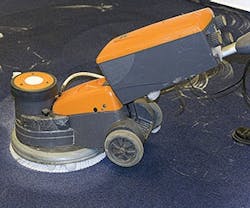If you think vacuuming and deep cleaning are your only weapons against carpet soiling, prepare to add another to your arsenal.
Low-moisture carpet care is familiar in the cleaning industry, but it is lesser known among building owners and facilities managers. It involves a variety of tactics and equipment, but some of the strategies can be performed by your staff.
Familiarize yourself with low-moisture methods and employ them before your carpet becomes washed up.
Definition and Methods
Low-moisture care refers to any type of carpet cleaning that allows fibers to dry and return to their natural state in two hours or less at approximately 65%
humidity and 70 degrees F., according to the Low-Moisture Carpet Cleaning
Association (LMCCA).
“Carpet hides dirt – this is a weakness, not a strength,” says John Holibaugh, secretary and treasurer of the LMCCA and regional sales manager at manufacturer Enviro-Solutions. “We can’t see soiling until it has layered from the bottom up. Low-moisture cleaning removes soils from the top before they become embedded.”
The most common low-moisture methods include the following.
- Bonnet: “With this system, a cleaning product is applied to the carpet and then extracted with an absorbent bonnet attached to a low-rpm floor machine that provides agitation to help loosen and remove soils,” explains Mark Cuddy, national sales manager of manufacturer U.S. Products.
When the carpets are dry, vacuuming is often recommended to remove any remaining chemicals or soils.
- Shampoo: This method deploys the same machine to distribute liquid detergent onto the carpet. It also agitates the fibers, similar to bonnet cleaning.
“Once this step is complete, the suspended soil is extracted along with the shampoo and moisture using a wet vacuuming system,” Cuddy says. “After drying, regular vacuuming removes any remaining residue.”
- Encapsulation: This strategy typically requires no water at all. Chemicals are applied to the carpet using a low-rpm or cylindrical machine that works them into the carpet using brushes instead of pads.
“These chemicals crystallize and encapsulate soils in about 30 minutes to an hour,” Cuddy explains. “Then the carpets are vacuumed, removing the crystals and soils along with them.”
Low-moisture carpet care is interim cleaning, and eventually, carpets must be cleaned using hot-water carpet extractors for a deeper job. However, low-moisture extractors are available. “These machines release less water into the carpet and have advanced moisture recovery vacuum systems,” Cuddy says.
Using a combination of heat, pressure, and suction, extraction is considered a deep cleaning method that gets beyond surface level soils. In addition to using more powerful vacuum motors than conventional extractors, low-moisture systems use 1 gallon compared to the typical 1.5 gallons of water per 300 square feet.
In-House vs. Outside Help
Now that you’re familiar with low-moisture care, the next question is whether you can implement it yourself.
“If your staff maintains the hard floors, they can perform low-moisture carpet cleaning,” Holibaugh says. “Training is the critical element.”
Equipment is also necessary, but for bonnet, shampoo, and encapsulation cleaning, the floor care equipment already used in the building is all you need, Cuddy says. “Facility custodial personnel can often perform low-moisture cleaning in-house,” he adds.
If your staff doesn’t handle floor care, find a qualified contractor, Holibaugh recommends. Likewise, when hot-water extraction is needed, an outside service should be called upon, advises Cuddy.
“Extractors can be costly, certainly more than everyday agitators and cleaning equipment. The work is fairly labor-intensive, and the technicians need special training and may even require Institute of Inspection, Cleaning, and Restoration Certification (IICRC) in order to protect the carpet’s warranty,” Cuddy adds. “FMs should focus on routine cleaning tasks and leave extraction to specialists.”
Low-moisture methods should be performed weekly with deep cleaning occurring monthly to yearly or even longer, Holibaugh explains.
Long-Term Benefits
“Low-moisture techniques not only improve carpet appearance, but it can also extend the useful life of the carpet, enhance the ability to service it, and minimize downtime waiting for areas to dry,” says Mark Warner, president of the LMCCA.
Drying quickly helps protect the carpet, its backing, and the subfloor beneath. It prevents moisture saturation that can result in the development of mold, mildew, bacteria, and other contaminants.
“Interim low-moisture care also aids in delaying the need to perform deep cleaning,” Holibaugh adds. “Carpet life can exceed its warranty and look good for 10 to 20 years if it’s maintained properly. Unfortunately, the average commercial life is four years.”
Although a greener method, this type of care offers the greatest value in delaying the need for more costly measures and providing quicker access to the space. However, it is underutilized.
“Because of carpet’s weakness of hiding dirt, low-moisture is generally not employed,” Holibaugh says. “But deep cleaning should only have to be used if dirt and soil overwhelm proper maintenance and low-moisture methods.”
Chris Curtland [email protected] is assistant editor of BUILDINGS.
